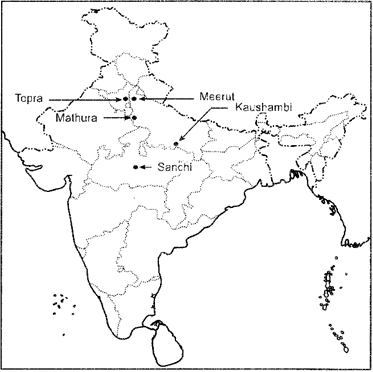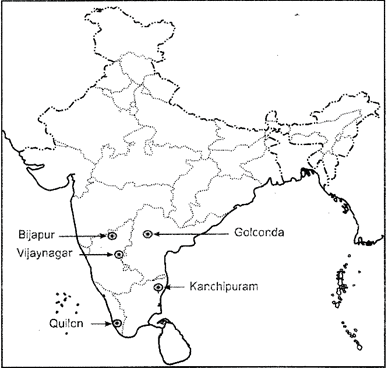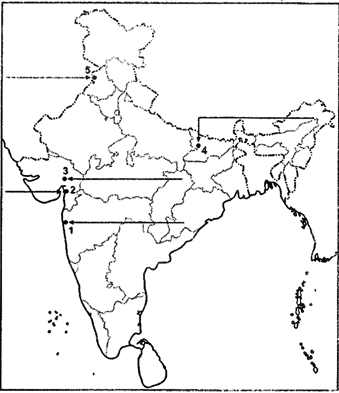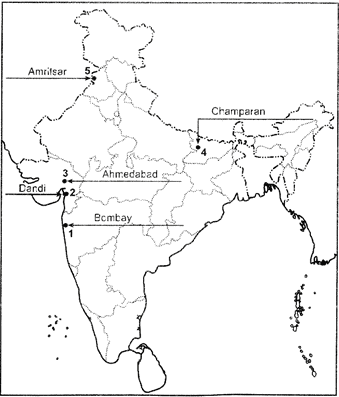Ques 1: Mention the two rules about classification of people in terms of 'gotra' under Brahmanical practice around 1000 BCE onwards.
Ans: Members from the same gotra could not marry each other. After marriage a woman had to give up ?her family gotra and take up that of her in-laws.
Ques 2: Mention the two ideas of Brahmanical system challenged by the Lingaytas.
Ans: They questioned the Brahmanical practice of maintaining purity in society by emphasizing on caste discriminations. They rejected the idea of rebirth, but believed in union with Shiva after death.
Ques 3: How were towns often defined in opposition to rural areas during precolonial times? Give any two points of difference.
Ans: 1. Towns thrived on the surplus and taxes obtained from agriculture practiced in the rural areas.
2. Towns occupied by artisans, traders, administrators, etc., were often fortified, demarcating itself from the countryside essentially comprising farmers.
Ques 4: Describe briefly the drainage system of the Harappan cities.
Ans: Harappan cities had a well-planned drainage pattern. It followed a grid structure with straight streets crossing each other at right angles. It is assumed that the houses were later laid out taking the drainage pattern into consideration. Every house had a drain connected to the street drains.
The main drains were made of brick and mortar and covered with loose mortar or limestone for easy cleaning. Long channels had sumps at intervals. The solid matter from waste water flowing out through house drains got collected in a sump, then allowing the waste water flow into the street drains.
Ques 5: Describe the sources used to construct the history of the Mauryan Empire.
Ans: Besides certain architectural findings like pieces of sculpture, scholars have relied on several sources of information about the Mauryan Empire. The records of Greek ambassador Megasthenes to the court of Chandragupta Maurya and the Arthasahastra, believed to be written by Chanakya or Kautilya, perhaps a minister at Chandragupta Maurya's court, seem to provide with valuable insights about the empire.
Further, Buddhist, Jain, Puranic and Sanskrit texts mention about the empire. However, Ashoka's inscriptions on rocks and pillars and his propagation of Dhamma is the most valuable source of information about the dynasty as he was the first ruler of the empire who inscribed messages for his subjects.
Ques 6: Who composed the original story of the text of Mahabharata? Describe the various stages through which the Mahabharata was completed between the 5th century BCE and 400 CE.
Ans: The Mahabharata traditionally believed to be composed by sage Vyas, evolved with time and had undergone several modifications in every phase of historical development. Originating as poems recited by sutas who accompanied Kshatriya warriors to the battlefield, in the fifth century BCE, at a time when the Kurus and the Panchala chiefdoms who have been mentioned in the narrative were becoming kingdoms, the Brahmans gave shape to these oral verses a written form. Then again, between 200BCE and 200 CE, the worship of Vishnu was increasingly gaming ground.
With Krishna as one of the main protagonists in the narrative, didactic verses from the Manusmriti were added. Thereby the Mahabharata, originally comprising 10,000 verses, with the passage of time, evolved into a narrative of more than 100,000 verses.
Ques 7: Explain any five elements considered by the historians while analyzing the texts.
Ans: While interpreting texts historians need to understand the background of the composers, what has been written and for whom, the language used and the manner in which the text was circulated. The composers position in society - if they held a position of authority - played an important role since it determined the language and purpose of the text. For instance, the Sanskrit texts of Mahabharata were composed by Brahmins and these were didactic in nature, describing social norms of behaviour. The Pali or Prakrit works on the same, however, reveal that these texts have often been questioned in the texts written in other languages.
Ques 8: How and when were the ruins of Hampi brought to light? Explain briefly.
Ans: Colonel Colin Mackenzie, the first Surveyor General of India, an employee of the East India Company, and an avid cartographer and engineer, wanted to understand Indians past to make colonial administration more effective. He made the first survey map of the ruins of the Vijayanagar Empire in the Tungabhadra-Doab region in 1800.
He initially relied on oral tradition, narrations by priests of the temples of Virupaksha and the local mother goddess Pampadevi. In fact, the name Hampi was derived from Pampadevi. Epigraphic records of temple inscriptions collected since 1836 and photographs of monuments since 1856 were collated with foreign travelers? accounts recorded in Telegu, Kannada, Tamil and Sanskrit.
Ques 9: Describe three factors that accounted for the constant expansion of agriculture during sixteenth and seventeenth centuries.
Ans: With perennial rivers and regular precipitation, most of the land was conducive for growing two/do fasla crops a year - the kharif (autumn) and rabi (spring). With the growth of irrigation, this became even thrice, and arid regions were also made cultivable. Apart from growing staple crops like rice, wheat and millet, Mughals encouraged growing revenue crops, for example, corton in Deccan Plateau and sugar in Bengal.
Farmers generally tilled their own land (khud kashta) but cultivators from other villages often joined them (pahi kashta) either owing to economic distress or by choice. Thus, abundance of land, availability of labor and mobility of peasants helped agriculture to expand.
Ques 10: 'The keeping of exact and detailed records was a major concern of the Mughal administration.' Support the statement with facts
Ans: The Mughal rulers believed that they were assigned by Divine Will to rule over a heterogeneous population. To make this vision a reality, it was politically necessary to establish their supremacy, by recording the achievements of the respective dynasties. The rulers thereby commissioned courtiers to write a detailed account of the events during the emperor's time.
Further, these scribes also gathered information about the regions to help the ruler assess the administrative needs of the kingdom. These chronicles, as the accounts were called, also provided the interpretation and importance of several administrative measures or imperial ideologies that the ruler might have introduced during his reign.
Ques 11: Why did the zamindars fail to pay the revenue demand in the early decades after the permanent settlement? Explain any two reasons briefly.
Ans: The Permanent Settlement, initiated in 1793, imposed on the zamindars the responsibility to collect land revenue and pay a fixed amount to the Company. Several zamindars defaulted payment as the revenue demand was high, being assessed at a time when prices were depressed, hence ryots were unable to pay, increasing the zamindar's unpaid balances. The Company had implemented this to ward off any anticipated loss as it revenue share was fixed, once the system became streamlined, agricultural production rose and prices increased.
Further, the Company's demand remained invariable, irrespective of the harvest and had to be paid within the given time.
Ques 12: Explain the provisions of the Subsidiary Alliance imposed on Awadh in 1801 by the British.
Ans: To gain complete suzerainty over India, the British wanted 10 include Awadh after annexing Bengal, the Punjab, Carnatic, Doab and the Maratha lands. Owing to the imposition of the Subsidiary Alliance in 1801, the Nawab of Awadh had to disperse his army and allow the British troops to station themselves in his kingdom.
He had to act as per the dictates of the British Resident positioned at his court. With his increasing dependence on the British forces for the upkeep of law and order, die Nawab gradually began to lose hold over the rebellious local chiefs and taluqdars who were keen to gain independence.
Ques 13: 'Some scholars see Partition as a culmination of communal politics that started developing in the opening decades of the twentieth century.' Examine the statement.
Ans: The British, had initiated separate electorates for Muslim in 1909 and had expanded it in 1919. Obtaining a chance to elect their own leaders in designated constituencies the respective representatives took to showing allegiance to members of their community and granting them favour, Religious identities evident as differences in faith and beliefs gradually got translated into violent hostilities against the other community.
Though separate electorates did have an impact on Partition, it cannot be considered as the most significant trigger. In the 1920s, issues like the cow protection movement, forcing of Muslim converts to obtain, shuddhi by she Aryan Samaj members and increasing sectarian propaganda by Muslims fueled communal apprehensions farther.
Ques 14: The discussions within the Constituent Assembly were also influenced by the opinion expressed by the public. Examine the statement.
Ans: The happenings and debates held at the Constituent Assembly were reported regularly through the newspapers. The public also debated on the proposals that were deliberated in the Assembly Further, the press reacted for and against the proposals, m the process creating a consensus on the subject.
To encourage collective participation, issues were thrown open for public discussion leading to overwhelming response from the people. Often the voices offered conflicting opinions and it was hard for the law makers to arrive at the correct decision. Hence while sonic wanted to prohibition of cow-slaughter, members from low caste and minority religions wanted special representations and safeguards.
Ques 15: Explain the striking features about the location of Vijaynagara, its water resources and its fortifications.
Or
Explain how during 16th and 17th centuries agriculture was organized around two major seasonal cycles by giving examples of different crops.
Ans: Situated in the Bellary district of Karnataka, the Vijaynagar empire was located south of the Deccan Plateau in the Tungabhadra basin, flanked on its north by the Sultanate empire of the Deccan and the Gajapan kingdom of Orissa.
Situated in a rocky terrain, with extreme dry conditions, and encircled by stark granite hills, the basin was watered by the Tungabhadra river which flowed in the north - easterly direction.
As the economy depended completely on agriculture, Vijaynagar's rulers paid special attention towards the creation of an efficient system of irrigation, using the several streams feeding the Tungabhadra river, building embankments along the Tungabhadra river to create reservoirs, establishing an extensive network of canals and aequeducts to feed the fields and constructing several tanks to store rainwater.
A striking example is me Kamalapuram tank. Canals connected to this tank supplied water to the fields and to the royal centre. The irrigated valley of the empire lay in - between the sacred zone and the urban core of the empire. As per epigraphic sources, the rulers of the Sangama dynasty had constructed the Hiraya canal to draw water from a dam built on the Tungabhadra River.
Several travellers have elucidated on the intricate water resource network of the Vijaynagar empire. Domingo Paes, a Portuguese traveller who visited the empire around the first half of the sixteenth century, mentions about a tank built between two adjacejt hills by Krishnadeva Raya, the most prominent ruler of the empire. The tank, which collected the water flowing down the hills, was connected by pipes running over a distance of 15 km to a lake which again flowed into a river.
Three ornamental pillars, lining the tank, were supposedly connected with pipes to water the rice fields and gardens.
Another unique feature of the empire was its fortifications. Abdur Razzaq, the Persian ambassador to Calicut, observed that between the first, second and the third walls [o the fortifications that encircled the region] there are cultivated fields, gardens and houses. To oust any possibility of running out of stock of grains during a siege and ensure its sustainability, the Vijaynagar rulers constructed seven lines of forts surrounding the city and the agricultural hinterland.
The wedge-shaped stones fitted into each other. Cement or mortar was not required to hold the stones together. The huge masonry constructions had a tapering appearance. The inner walls were made of earth lined with rubble. The bastions that protruded outwards were either square or rectangular in shape.
While each important building in the royal centre was guarded by high walls, the royal enclave itself was again encircled by fortifications and the inner core of the urban centre also had another row of fortifications. Gateways flanking the entrance to the forts and connecting the roads with the city centre had arches and domes with intricate patterns, revealing Indo-Islamic influences because of the close proximity of the Turkish Sultans to the empire. The Vijaynagar empire thus stands apart with regard to its location, managemen of water resources and intricate fortifications.
Or
In India the economy of the country largely depends on agriculture which in turn revolves around the monsoons. In the 16t and 1711 centuries too, the monsoons remained the backbone of the agricultural yield. However, in areas where the precipitation was low, the Mughal rulers took initiative in improving irrigation and repairing the existing network of canals. Except for the regions that had extremely dry conditions, generally there were two Seasonal cycles or at least two types of cropping patterns followed in 16th and 17th century India.
This meant that two crops could be grown in most cases during a period of one year-one, which was harvested during autumn, hence called the kharif (autumn) and two, which were ready by spring and known as rabi. In the Mughal period, apart from this two- crop or do fasla agricultural pattern, areas having adequate precipitation and irrigation coverage, also could grow three crops a year.
Records of the Ain-i-Akbari reveal that the agricultural produce increased to a great extent. While Agra produced 39 varieties, Delhi took pride in producing 43 types of crops within the two-season cycle. In Bengal where mostly rice was cultivated, there were 50 varieties of rice.
The primary focus of agriculture was to grow the staple crops like rice, wheat and pulses. A unique feature of Mughal administration is that the rulers also encouraged farmers to experiment with other crops besides the cultivation of staple crops.
Perfect crops or jins-i-kamil is an expression we often come across medieval records and cotton and sugarcane were considered as unique examples of the kind. There were other crops grown apart from those cultivated for sustenance. In a way this augmented the income from revenue and enriched the Mughal coffers.
Cotton was widely grown in Central India and the Deccan Plateau. Other cash crops like mustard and lentils also were widely grown. This period witnessed a marked increase in the yield of oil seeds. Owing to their abundance perhaps, in Akbar's time the price of oil seeds were even cheaper than wheat. Sugar was extensively available in Bengal. Sugar and Gur were manufactured from the sugarcane mills.
Tobacco which was first introduced in the Deccan gradually spread to northern India in the 17th century and gradually became immensely popular, so much so that by the end of the century it became one of the most important items of consumption and cultivation. Other new crops were introduced in the seventeenth century.
Maize or Makka was introduced from Africa and Spain and became largely popular. Owing to the New World, cultivators became familiar with other vegetables like tomatoes, chillies, potatoes and fruits like papaya and pineapple. A peasant successfully balanced the cultivation of sustenance and commercial crops in a normal holding within the seasonal cycle.
Ques 16: Explain the changes reflected in the history of urban centres in India during the 18th century with special reference to network of trade.
Or
Explain the sources from which we can reconstruct the political career of Gandhiji and the history of the nationalist movement.
Ans: During the 16th and 17th centuries the towns had a separate identity, remaining remote and distinct from the countryside, and being the hub of the imperial grandeur and centre of administration. With the ruler residing within a fortified region, medieval towns like Delhi and Agra became centres of power where artisans and craftsmen moved into offer services to the ruling elite.
Most of the eminent mansabdars and jagirdars resided in the towns as it was a symbol of power and prestige. Hence, the surplus agricultural produce was moved in from the countryside to feed the urban markets and town dwellers. With the treasury stationed in the imperial towns, revenues travelled into these imperial centres. Hence, towns comprised bazaars, temples, mosques, educational institutions and thrived with activity.
With the decline of the Mughal regime, many of the medieval towns plunged into decadence. New regional powers emerged and with them arose new centres of authority like Seringapatam, Than-iavur, Hyderabad, Poona, Nagpur, Lucknow, Baraoda and so on.
From- the old Mughal towns, traders, merchants and administrators now migrated to these new centres. Artisans and mercenaries flocked to me new settlements in hope of patronage and employment as owing to the severe tussle for power between the kingdoms, the newly developed urban centres were seats of constant warfare. Some members of the Mughal elite even bought qasbahs (small towns in the countryside) and ganjs (markets) to make new urban establishments.
With the European trading settlements gradually setting a firm hold in Panaji (Portuguese, 1510), Masulipatnam (the Dutch, 1605), Madras (British, 1639) and Pondicherry (French, 1673), with the increase of commercial activities, towns grew around these emerging centres. These places became important commercial centres.
Generally being maritime centres, these places, distinct from the earlier land - based urban imperial capitals, aroused new commercial opportunities, mercantilism and capitalism thereby bringing in changes in the existing socio-economic trends. However, from mid-eighteenth century Masulipatnam, Surat and Dhaka witnessed a marked decline as the trading pattern shifted.
In 1757 the British won the Battle of Plassey and set up its first political foothold. Along with this the English East India Company expanded its control as Calcutta, Bombay and Madras emerged as the new economic centres. Gradually as they expanded their sway over other parts of India, ousting the regional powers, these newly created commercial outposts grew in eminence. These centres gradually became important centres of colonial administration and political power.
To facilitate administrative requirements, new buildings and institutions were developed. The British rulers took upon themselves the task of rearranging urban spaces in new ways. With the development of educational institutions, new occupations emerged. A new elite educated bourgeoisie class emerged along with a new type of landed gentry and a trading class. People began to flock to these new centres for employment.
The economic and social pattern of the earlier years witnessed a complete turnover. These new places became bustling commercial and administrative centres of a colonial regime. By 1800 these places developed into prominent cities.
Or
Several sources have been accessed to get an overview of Mahatma Gandhi's political role and details about the unfolding of the nationalist movement. These include public speeches and private writings; autobiographies; articles and reports published in newspapers; and government records.
The most important point one needs to remember while studying the public-private documents is that one needs to see each of them in the right perspective and context. Public speeches delivered by Mahatma Gandhi and other nationalist and strategies.
The letters written to Gandhi or by other politicians may convey their deep frustrations, personal prejudices and biases which are meant to be private expression. But there is no assurance that these private get printed. But, me language, used in these private correspondences, often implies a certain degree of awareness of the writer that they may be printed.
In some cases these were done deliberately as did Gandhi who published the letters written to him in his Journal Martian. Even Jawaharlal Nehru, published, a collection of letters written to him during the national movement in his edited and complied volume of A Bunch of Old Letters.
Autobiographies written, by nationalist leaders like Gandhi or Nehru provide us with a clear picture about the protagonists of the narrative in the light they would like to see themselves. Retrospective by nature, these accounts provide a detailed human account of the issues and events that the author would like to recount from memory it is important for one to remember that while using these as sources one needs to craftily identify those issues that the author might have avoided referring" the conscious and unconscious omissions.
Government records provide us -with the colonial interpretation of the nationalist movement in India. Letters and reports that the colonial administrators exchanged amongst themselves within closed, doors to keep a close vigilance on the movement have now been available.
From these archival materials it becomes evident that these official accounts were often coloured, with racial bias and. with overtones of colonial supremacy over a mass of uncivilized natives. Thus the Fortnightly Reports on the Salt March mention that Gandhi's act did not receive much response from die masses who paid little heed and were preoccupied in running the daily chores and reluctant to rise against the British forces.
In fact the truth was actually just the contrary and Gandhi had been able to arouse public sentiments and shape them into a voluntary movement against the British. The reports represented accounts in the manner the British rulers would be glad to see or what they were willing to believe.
Newspapers published political events and the activities, demonstrations and meeting Gandhi attended. The reports were published in several nationalist newspapers and periodicals in English as well as in the regional languages. However, these accounts cannot be considered completely reliable as they were often prejudiced, reflecting the opinion and world view of those who published them. As a result different ideas emerged from contexts in which the articles were published.
Ques 17: Read the following passage carefully and answer the questions given at the end of it:
Why Kinfolk quarrelled?
This is an except from the Adi Parvan (literally, the first section) of the Sanskrit Mahabharata, describing why conflicts arose amongst the Kauravas and Pandavas:
The Kauravas were the ... sons of Dhritarashtra, and the Pandavas... were their cousins. Since Dhritarashtra was blind, his younger brother Pandu ascended the throne of Hastinapura ... However, after the premature death of Pandu, Dhritarashtra became king, as the royal princes were still very young.
As the princes grew up together, the citizens of Hastinapura began to express their preference - for the Pandavas, for they were more capable and virtuous than the Kauravas. This made Duryodhana, the eldest of the Kauravas jealous. He approached his father and said, "You yourself did not receive the throne, although it fell to you, because of your defect. If the Pandava receives the patrimony from Pandu, his son will surely inherit it in turn, and so will his son, and his.
We ourselves with our sons shall be excluded from the royal succession and become of slight regard in the eyes of the world, lord of the earth?
Passages such as these may not have been literally true, but they give us an idea about what those who wrote the text thought. Sometimes, as in this case, they contain conflicting ides.
(1) Why did the citizens of Hastinapur express preference for Pandavas?
(2) Explain the reactions of Duryodhana against Pandavas.
(3) Explain the criteria of patrilineal succession.
Or
Fatalists and materialists
Here is an excerpt from the Sutra Pitaka, describing a conversation between king Ajatasatru, the ruler of Magadha, and the Buddha:
On one occasion King Ajatasatru visited the Buddha and described what another teacher, named Makkhali Gosala, had told him:
Though the wise should hope, by this virtut. ...by this penance I will gain karma ... and the fool should by the same means hope to gradually rid himself of his karma, neither of them can do it. Pleasure and pain, measured out as it were, cannot be altered in the course of samara (transmigration). It can neither be lessened or increased ... just as a ball of string will when thrown unwind to its full length, so fool and wise alike will take their course and make an end of sorrow." And tills is what a philosopher named Ajita Kesakambalin taught:
"There is no such thing, 0 king, as alms or sacrifice, or offerings...... there is no such thing as this world or the next...A human being is made up of the four elements. When he dies the earthy in him returns to the earth, the fluid to water, the heat to fire, the windy to air, and his senses pass into space...
The talk of gifts is a doctrine of fools, an empty lie ... fools and wise alike are cut off and perish. They do not survive after 'eath'.
The first teacher belonged to the tradition of the Ajivikas. They have often been described as fatalists those who believe that everything is predetermined. The second teacher belonged to the tradition of the Lokayatas, usually described as materialists. Texts from these traditions have not survived, so we know about them only from the works of other traditions.
(1) Explain what had Makkhali Gosala told the King Ajatasatru.
(2) Explain what did the philosopher named AJita Kesakambalin teach.
(3) Describe the beliefs of fatalists.
Ans:
Why Kinfolk quarrelled?
(1) The citizens of Hastinapur preferred the Pandavas because the eldest brother Yudhisthir, son of Pandu, was older than Duryodhana, the first son of Pandu's brother Dhritarashtra. Though hierarchically speaking, Dhritarashtra had the first claim to the Hastinapur's throne, since he was blind, Pandu, his younger brother was made the king. But soon Pandu died.
As the princes were young Dhritarashtra became the king. Hence, the Pandavas had direct claim to the throne. Also, they were courageous and chivalrous warriors and thoughtful about the welfare of the people of Hastinapur, hence preferred by the citizens of Hastinapur as the rightful heirs to the throne.
(2) Duryodhana claimed that Dhritarashtra had been forced to relinquish his rightful authority upon the throne of Hastinapur and was penalized for being handicapped. Owing to his inability the line of succession has passed on to the other branch in the family.
In this way, by forsaking the throne once he has lost the opportunity of making his sons the rightful owner. As Pandu was the last ruler the line of succession would always be in the name of his five sons and their successors.
(3) Patrilineal succession ensures the eldest son of the ruler to succeed to the throne. Upon the death of the eldest son, the throne would pass on to the next brother in line of succession. If there are no male siblings, the throne would pass to the eldest grandson of the first son of the ruler.
Or
Fatalists and Materialists
(1) Makkhali Gosala told the king, "Though the wise shows hope, by this virtue by this penance I will gain Karma pleasure and pain, measured out as it were, can't be altered in course of Samara. It can neither be lessened nor increased.....to its full length, so fool & wise alike will take their course and make an end of sorrow."
(2) Ajita Kesakambalin, a philosopher, taught, "There is no such thing, 0 king as alms or sacrifice or offerings, there is no such thing as this world or the next. The talk of gifts is a doctrine of fools. They do not survive after death.
(3) The fatalists believe that everything is predetermined. Pleasure and pain, measured out as it were, can't be altered in the course of samsara. It can neither be lessened nor increased.
Ques 18: Read the following passage carefully and answer the questions that follow:
The One Lord
Here is a composition attributed to Kabir
Tell me, brother, how,,, can there be
No one lord of the world but two?
Who led you so astray?
God is called by many names
Names like Allah, Ram, Karim, Keshav, Hari, and Hazrat.
Gold may be shaped into rings and bangles.
Isn't it gold all the same?
Distinctions are only in words that we invent.........
Kabir says they are both mistaken.
Neither can find the only Ram. One kills the goat, the other-cows.
They waste their lives in disputation.
(1) Name any two scriptures in which verses, ascribed to Kabir, have been compiled.
(2) How did Kabir describe the 'Ultimate Reality'?
(3) Explain the arguments given by Kabir against the lords of the world of different communities.
(4) Do you agree with Kabir? Give your own views as well.
Or
A warning for Europe
Bernier warned that if European kings followed the Mughal model:
Their kingdoms would be very far from being well-cultivated and peopled, so welt built, so rich, so polite and flourishing, as we see them. Our kings are otherwise rich and powerful; and we must avow that they are much better and more royally served.
They would soon be kings of deserts and solitudes, of beggars and barbarians, such as those are whom I have been representing (the Mughals) ... We should find the great Cities and the great Burroughs (boroughs) rendered uninhabitable because of ill air, and to fall to ruine (ruin) without any bodies (anybody) taking care of repairing them; the hillocks abandoned, and the fields overspread with bushes, or filled with pestilential marishes (marshes), as hath been already intimated.
(1) What kind of warning European traveller wants to give? Describe briefly.
(2) 'On what accounts Bernier's description was at variance with the contemporary Mughal records.? Explain.
(3) Explain Bernier's suggestions given about the great cities.
Ans: (1) Following are two scriptures in which veres ascribed to Kabir compiled:
(i) Kabir Bijak
(ii) Kabir Granthavali
(2) Kabir described the "Ultimate reality" as Allah, Khuda, Hazrat and Pir. He also used terms taken from vedantic traditions Alakh, Nirankar, Brhman, Atman etc.
(3) Kabir says that there is one Lord of the world and he is called by many times like Allah, Ram, Karim, Keshav, Hari, and Hazrat, Kabir says that these distinctions are due to words we invent.
(4) I absolutely agree with Kabir's views. I think that God is one. He may called by many names. Kabir s views are perfectly logical and secular in truest: sense.
Or
(1) European traveller Bernier warned that if European kings followed the Mughal model their kingdoms would be very far from being well-cultivated peopled, so we built, so polite and flourishing as we see them,
(2) According to Bernier one or the main differences between Mughal India and Europe was the lack of private property in land in former. He maintained that the crown ownership of land was harmful for both the state and its people.
(3) Bernier gave suggestions about great cities. The cities and towns of the Mughal Empire were ruined and contaminated will ?ill air and its fileds overspread with bushes and full of pestilineal mashes.
Ques 19: Read the following passage carefully and answer the questions that follow:
'That is very good, Sir - bold words, noble words?
Somnath Lahiri said:
Well, Sir, I must congratulate Pandit Nehru for the fine expression he gave to the spirit of the Indian people when he said that no imposition from the British will he accepted by the Indian people. Imposition would be resented and objected to, he said, and he added that if need be we will walk the valley of struggle. That is very good. Sir - bold words, noble words.
But the point is to see when and how are you going to apply that challenge. Well, Sir, the point is that the imposition is here right, row. Not only has the British Plan made any future Constitution ... dependent on a treaty satisfactory to the Britisher but it suggests that for even, little difference you will have to run to the Federal Court or dance attendance there in England; or to call on the British Prime Minister Clement Attlee or someone else.
Not only is it a fact that this, Constituent Assembly, whatever plans we may be hatching, we are under the shadow of British guns, British Army, their economic and financial stranglehold - which means that the final power is still in the British hands and the question of power has not yet been finally decided, which means the future is not yet completely in our hands.
Not only that, but the statements made by Attlee and others recently have made it clear that if need be, they will even threaten you with division entirely. This means, Sir, there is no freedom in this country.
As Sardar Vallabh Bhai Patel put it some days ago, we have freedom only to fight among ourselves. That is the only freedom we have got ... Therefore, our humble suggestion is that it is not a question of getting something by working out this Plan but to declare independence here and now and call upon the Interim Government, call upon the people of India, to stop fratricidal warfare and look out against its enemy, which still has the whip in hand, the British Imperialism-and go together to fight it and then resolve our claims afterwards when we will be free.
(1) Why did Somnath Lahiri congratulate Pt. Nehru?
(2) Explain why Somnath feels that the absence of constitution will mean dependence on the British.
(3) How did he feel that the final power was still in the hands of the British?
(4) Explain the views of Sardar Vallabh Bhai Patel.
Or
'The real minorities are the masses of this country'
Welcoming the Objectives Resolution introduced by Jawaharlal Nehru, N.G. Rangy said.
Sir, there is a lot of talk about minorities. Who are the real minorities? Not the Hindus in the so called Pakistan provinces, not the Sikhs, not even the Muslims. No, the real minorities are the masses of this country.
These people are so depressed and oppressed and suppressed till now that they are not able to take advantage of the ordinary civil rights. What is the position? You go to the tribal areas. According to law, their own traditional law, their tribal law, their lands cannot be alienated. Yet our merchants go there, and in the so called free market they are able to snatch their lands.
Thus, even though the law goes against this snatching away of their lands, still the merchants are able to turn the tribal people into veritable slaves by various kinds of bonds, and make them hereditary bond-slaves. Let us go to the ordinary villagers. There goes the money-lender with his money and he is able to get the villagers in his pocket. There is the landlord himself, the zamindar, and the malguzar and there are the various other people who are able to exploit these poor villagers.
There is no elementary education even among these people. These are the real minorities that need protection and assurances of protection. In order to give them the necessary protection, we will need much more than this Resolution...
(1) Who are the real minorities according to Shri N.G. Rangy and why?
(2) Explain N.G. Ranga's views about the condition of ordinary villagers.
(3) Mention the views of Prof. N.G. Ranga regarding the tribal areas and the tribal law.
Ans: A small basket of grapes
(1) Somnath Lahiri congratulated Pt. Nehru for the fine expression he gave to spirit of an Indian people when he said that no imposition from the British will be accepted by Indian people.
(2) Somnath Lahiri felt that the absence of constitution would mean dependence on the British because for every little difference we shall have to run to the Federal Court or dance attendance there in England or the call on the British prime minister or someone else.
(3) Somnath Lahiri felt that the final power was stored in the hands of British because this financial stronghold which means that the final power is still in the British hands and the future is not yet completely in our hands.
As Sardar Vallabh Bhai Patel opened that we had freedom among ourselves. The interim government and the people of India to fratricidal warfare's to fight the British imperialism and resolve our claims afterwards when we will be free.
Or
(1) According to Shri N. G. Ranga the real minorities are the masses of this country. They are not able to take advantages of the ordinary civil rights.
(2) N. G. Ranga writes about the condition of ordinary villages. The money-lender with the power of his money is able to get the villagers in his pocket. The landlord, zamindar and the malguzar flagrantly exploit the poor villagers.
(3) Prof. N. G. Ranga mentions his views regarding the tribal areas and the tribal law as under. If we go to the tribal law, according to their lands can't be aliented. However the merchants visit the tribal areas and in the so called market they snatch their lands.
Ques 20: On the given political outline map of India mark and label the following mature Harappan sites Rakhigadi, Nageshwar, Lothal, Kalibangan, Kotdiji.
Or
On the given political outline map of India mark and label the following territories under Babar, Akbar and Aurangzeb: Delhi, Goa, Agra, Ajmer, Amber.
Ans:

or

Ques 21: On the given political outline map of India five important centres of the Indian National Movement have been marked as 1, 2, 3, 4, 5. Identify them and write their names on the lines drawn near them.

Ans:





























